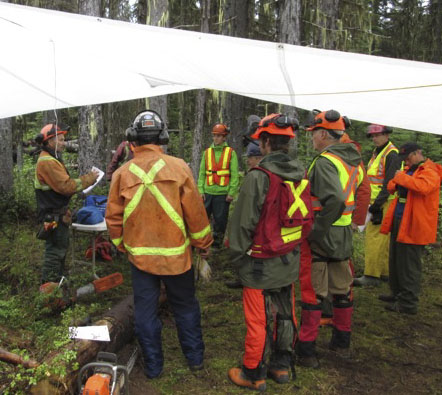|
VOLUNTEERING AND PROJECTS
You can become involved in the Rossland Range Recreation Site by volunteering to help with various projects we've begun (and others you might think of). See the Contacts page for an idea of which projects are in need of help or a coordinator. Below is a description of some of the projects:
-
Access: As the forest in the Recreation Site changes over time, we will need to actively keep access routes and skiing slopes open and safe. The Management Plan includes some helpful rules about how to do that, and some examples of potential projects. If you would like to help with things like clearing brush, dropping hazardous windfall trees, or thinning dense young growth, or if you have an idea for an access project, contact the Rec Site's Access Coordinator. As described in the Plan, Atco Wood Products, the forest tenure holder, has asked that we discuss any access projects with them.
-
Day-Use Cabins: Our chain of day-use cabins lies at the heart of what the Recreation Site offers. The Management Plan explains how the cabins are intended to be managed for the future, with suggested projects and phases. If you would like to help with any aspect of building or maintaining the day-use cabins, get in touch with our Day-Use Cabin Coordinator.
Users of the Rossland Range Recreation Site are now covered by insurance provided by the Recreation Sites and Trails Branch. This insurance also includes volunteers working on Recreation Site projects, but only if the volunteers operating chainsaws get basic certification in chainsaw safety. Without the certification, the chainsaw operator will not be covered by the insurance, as in "the olden days" .
On a rainy day at the end of May, 2015, volunteers took the free chainsaw certification course. The guys were already fairly good with chainsaws so the 2 instructors certified them and now they will be insured while working in the Recreation Site. |

Volunteers taking a chainsaw certification course on a rainy May day. PHOTO: Bob McQueen |
-
Environmental information: All activities to develop the Recreation Site must be planned with their environmental impact in mind, see the examples below. If you are interested in more information, contact our Environmental Coordinator (see the Contacts page) .
Riparian Areas (streams and wetlands):
Riparian areas are important for maintaining channel stability, water quality, providing habitat and serving as wildlife corridors. Recommendations: Avoid riparian areas and when this is not feasible use best management practices when working near watercourses.
Alpine Areas: Alpine areas are susceptible to environmental damage and slow to recover. This rare ecosystem contains several sensitive flora and fauna species. Recommendations: Avoid development of any new permanent trails in alpine areas. Encourage users to stay on trails.
Wildlife Habitat Areas: Several wildlife species that use the Rossland Range are sensitive to human activities. Protecting the habitat of these species will benefit all wildlife in the Rossland Range. Recommendations: Work with biologists, local stewardship groups, and Selkirk College to identify important wildlife habitat. Encourage reporting of sensitive wildlife species to document where use occurs within the Rossland Range.
Wildlife Trees:
Wildlife trees are important for nesting habitat for birds and offer habitat to several wildlife species through their decay cycle. Recommendations: Do not remove any trees greater than 60 cm in diameter or showing signs of wildlife use (e.g. cavities, nests). Do not remove any timber within 50 metres of any stream or wetland.
-
Signs: The Recreation Site will require several sorts of signs, starting with those telling the public that they are now in a special place, the Rossland Range Recreation Site. If you are interested in helping with signs, or if you have an idea about what signs might be needed, you can contact our Sign Coordinator (see the Contacts page).
-
Public education: The Recreation site offers many opportunities to educate people about its natural and cultural heritage, from forest interpretation trails to stream and wetlands studies to exploration of the human history of the area. Field trips, brochures and school projects are all possible, but we don’t presently have a person to coordinate those kinds of things. If you would like to be involved, you can contact the Chair of the Board of the Friends of the Rossland Range (or any FORRS director). See the FORRs Contacts page for all FORR Board members.
-
Old Glory Lookout Heritage Site: Separate from the on-going development and management of the Recreation Site, FORRS and the Recreation Sites and Trails Branch of the government have been working on a project to restore the forest fire lookout on the summit of Old Glory as a heritage site. If you are interested in helping with this project, you can contact the Old Glory Lookout Heritage Site Coordinator (see the Contacts page) .
|
|




